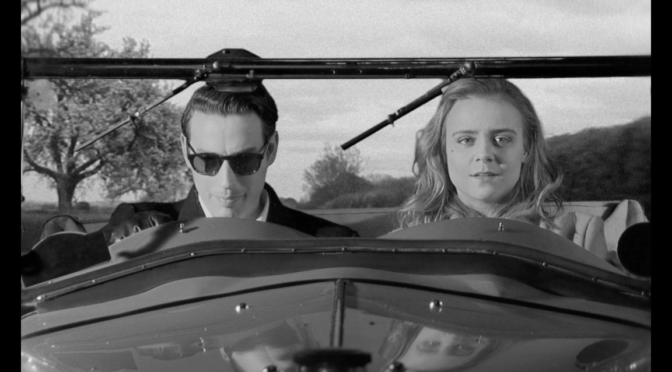![]() FrightFest never fails to illuminate the creative genius of the horror genre, and it also provides a glowing platform for new filmmakers. Jack McHenry may only have one feature to his name, but the aesthetic brilliance within his debut film HERE COMES HELL pays captivating tributes to the vintage eras of Hammer House, Tourneur’s Noir, and Rami’s novelty.
FrightFest never fails to illuminate the creative genius of the horror genre, and it also provides a glowing platform for new filmmakers. Jack McHenry may only have one feature to his name, but the aesthetic brilliance within his debut film HERE COMES HELL pays captivating tributes to the vintage eras of Hammer House, Tourneur’s Noir, and Rami’s novelty.
Set in the 1930s, a group of friends is gathered at a dishevelled mansion, recently acquired by the flamboyant Victor (Charlie Robb), who is hosting an eccentric dinner party. The guests include narcissistic tennis player Teddy (Timothy Renouf), delicate Texan George (Tom Bailey), contemptuous femme fatale Christine (Margaret Clunie), and Teddy’s introverted, proletarian girlfriend Elizabeth (Jessica Webber). The evening unravels in a tense fashion; through Christine’s vocal distaste for Elizabeth’s angelic persona, and George’s unrequited love for Catherine; in which his obtusity obstructs his desire for catharsis. As the night unfolds Victor’s true agenda for the evening is revealed, as he brings his friends together with manic medium Madame Bellrose (Maureen Bennett), to summon the spirit of the occultist, and former owner of the mansion, Ichabod Quinn (Nicholas Le Prevost). What begins as a curious experiment rapidly descends into a fight for survival, where unresolved conflicts could be the catalyst to demonic possession, dismemberment, and death.
HERE COMES HELL is a well-executed homage to the defining developments in the horror genre: Gothic, Supernatural, Body, Rural and Comedy Horror. Where subgenres should clash, McHenry formulates a stimulating blend of nostalgia in modernity. The directorial elements throughout transport us back to the 1930s, with the theatrical, introductory narrator, the technique of Rear Projection within McHenry’s car scene, to the carefully crafted dialogue which gels in historically faithful melodies to the setting. The illusion loses stability when fantastical disruptions through comedic abstracts of Body Horror dominate the core of McHenry’s artistically fluid composition, delivering us to the romp regions of 80s extravagance – starkly establishing that it is not a flick to be taken too seriously. The horror films of the modern age are geared towards innovations of genre and style; and where many flop from an inability to create a fresh auteurship, McHenry excels in his work’s reflections on an array of influences from the past. Through McHenry’s debut there is a clarity that aspires to remind those in front of the lens that new models of narrative and aesthetic styles must have a connection to the artistic structures of the past, and no auteurs are void of inspirations.
The performances in HERE COMES HELL are emphatically impressive, with Margaret Clunie, Timothy Renouf and Jessica Webber standing out, and deriving acute sincerity to their somewhat genre-typical roles. Clunie radiates the screen as the acrimonious Catherine, and with each cigarette flick a rancorous remark follows in a darkly comic rhythm. Renouf’s depiction of the vain, womanising Teddy, fluctuates from a dyad of Bond-like sophistication to Frank N Furter undertones of seductive seediness. Jessica Webber’s embodiment of the final girl has the most developed transition, from the neurotic hunches of Wendy Torrance to the ruthless rebellion of Sharni Vinson’s Erin in Wingard’s YOU’RE NEXT.
McHenry’s approach to the horror genre is driven through profound respect and revelry to his directorial predecessors. HERE COMES HELL is more than your conventional horror feature, it is a celebration of the experimental artistry, and the imaginative realms of horror cinema; that remains frequently disregarded within cinema institutions. It is unclear what category HERE COMES HELL will fall into in cinema and fan culture, but with McHenry’s technical advancements surpassing the expectations of low-budget film, he will certainly find his place in the parade of Cult Cinema.

